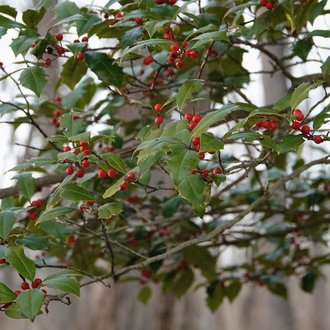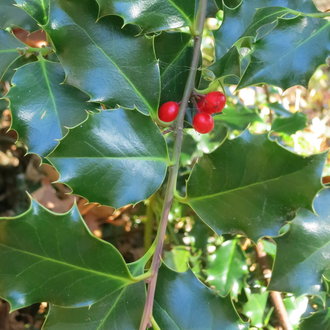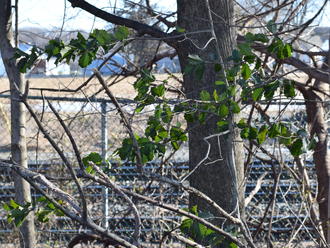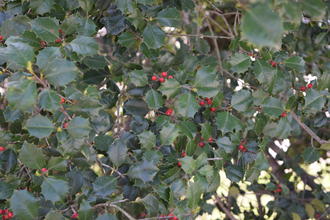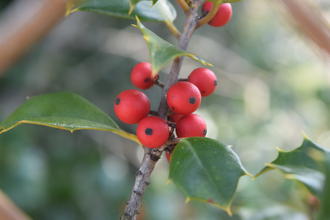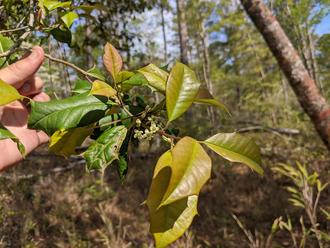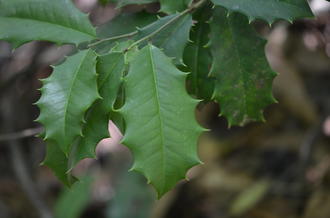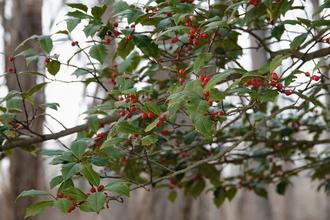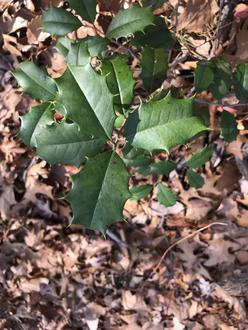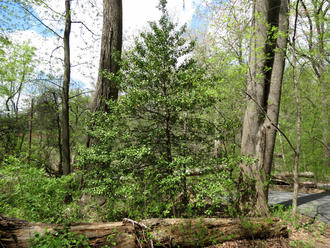American Holly (Ilex opaca Aiton)
↑Summary
A broadleaf evergreen tree that has the most northerly distribution of any broadleaf evergreen tree in North America; among other evergreen plants, only smaller shrubs and conifers persist farther north. Common and widespread in much of its range.
↑Description & Identification
A broadleaf evergreen tree with spiny leaves and a pyramidal shape.
↑Similar Plants
↑Habitat
Found in rocky wooded slopes, well-drained sites in bottomland woodlands, raised areas around swamp margins, sheltered sites near coastal sand dunes, and small forest fragments along roads and railroads and in suburban areas.
Prefers moist to mesic, well-drained, slightly acidic soils, often containing some sand or rocky material. Can tolerate clay soils on well-drained sites. Like most broadleaf evergreen trees, it requires some protection from wind in winter, especially in the colder parts of its range. Prefers sun to light shade, but tolerant of moderate shade. Susceptible to fire due to its thin bark. Tolerates pollution and resistant to browsing from deer.
Humans have probably increased the habitat for this species through multiple means, including fire suppression in areas with rocky or sandy soils, deer overpopulation, and pollution which affects this species less than many others, as well as altering of the environment around roads and homes in flat terrain and bottomlands to create more well-drained sites.
↑Life Cycle
American Holly is a slow-growing, shade-tolerant species that usually grows as a medium-sized understory tree.
Seeds germinate on the surface of the ground, in response to light. Although trees can tolerate sunny exposures, they are highly shade-tolerant at all stages of their lifespan, and survival is high on most sites with enough light to trigger germination. Seedlings are often overtopped by competing trees or shrubs, but survive underneath them and eventually grow up to maturity.
Trees begin flowering as young as 4-7 years, but flowering may be delayed longer on heavily-shaded individuals. Male and female flowers are borne on separate trees, and are insect-pollinated. Seed production is inconsistent, and can be hindered by heavy spring rains that hinder the distribution of pollen, as well as frosts during the blooming period.
Fruit ripens in fall, but often remains on the tree well into winter. The berries become increasingly attractive to fruit-eating birds later in winter as freeze-thaw cycles break down the starch in the fruits into sugar, and also as other food sources become scarce. Fruits are eaten both by resident birds such as Northern Mockingbirds, and migrating birds such as the American Robin.
Seeds have a prolonged dormancy period, even after passing through the digestive system of a bird, and usually do not germinate until after two or possibly three winters. The seeds form a short-term seed bank, with most germinating in their second or third spring, and only small numbers persisting longer.
Trees can live as long as 100 years.
Top-killed plants will resprout, but other than resprouting this species does not reproduce vegetatively.
↑Faunal Associations
The flowers are insect-pollinated, and there are also numerous insects that eat the leaves and twigs.
Birds, including the American robin and Northern Mockingbird, eat the berries in winter. Often, birds leave the berries on the tree initially and only start eating them later in the season.
↑Uses
Widely planted as a landscaping plant where it is valued for its attractive evergreen foliage, bright red berries, adaptability to a wide range of sites, and cold-hardiness among broadleaf evergreens. Can be planted considerably north of its native range. Survives and sometimes thrives in considerably colder areas when sheltered from wind in winter, with perhaps some help from urban heat island effect.
↑Related Plants
There are numerous other hollies (Ilex sp.) in North America; one analysis found that this species is probably closest-related to species that only occur farther south, primaily Ilex dugesii, followed by Ilex rubra. Among species found in the US, it is probably closest-related to myrtle dahoon (Ilex myrtifolia) and dahoon (Ilex cassine), followed by sarvis holly (Ilex amelanchier). This species hybridizes in the wild with dahoon to form topal holly (Ilex ×attenuata).
↑Links & External Resources
• Holly | The Wood Database (About This Site)
• American Holly | Fire Effects Information System (FEIS) (About This Site)
• Ilex opaca (American Holly) | Illinois Wildflowers (About This Site)
• Ilex opaca (American Holly) | USDA PLANTS Database (About This Site)
• Ilex opaca | Go Botany (About This Site)
• American Holly | iNaturalist (About This Site)
• Ilex opaca (American Holly) | Missouri Botanical Garden Plant Finder (About This Site)
• American Holly | Virginia Tech Dendrology Factsheets (About This Site)
• American Holly | Silvics of North America (About This Site)
• Ilex opaca | Biota of North America Project (BONAP) (About This Site)
• Ilex opaca | NatureServe Explorer (About This Site)
• American Holly | Maryland Biodiversity Project (About This Site)
• Ilex opaca Aiton var. opaca (American Holly) | Digital Atlas of the Virginia Flora (About This Site)



